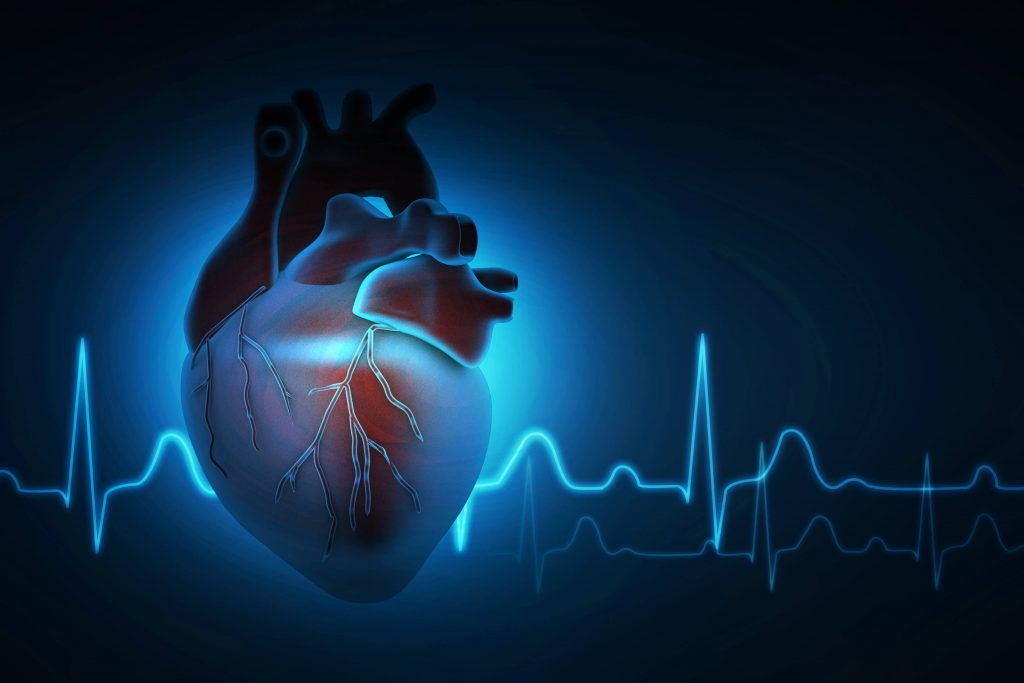What is Cardiac Arrhythmia?

The heart’s primary function is to pump blood throughout the body. This is done by an electrical connection that originates from the sinoatrial node (SA node). The electrical impulse begins at the SA node travels throughout the heart. The electrical impulse travels along a pathway through the heart to create the heart’s movement. The movement or pumping is what allows the blood to flow in and out of the heart in the appropriate direction. A disturbance in that electrical pathway can impact the heart’s ability to pump blood or heart rate. Changes to the heart’s electrical impulses result in irregular heartbeat / heart rhythm or cardiac arrhythmias.
Types of Cardiac Arrhythmia
Cardiac arrhythmias are any type of irregularity in heart rhythm which results in a change in heart rate. Arrhythmias are classified by the impact they have on heart rate and where the heart they originate:
Tachycardia
A cardiac arrhythmia that creates a faster than usual heart rate.
Bradycardia
Arrhythmias create slower than resting heart rates.
Are Arrhythmias a Symptom of Heart Failure?
Arrhythmias can also impact heart rate as a flutter in heart rate or premature heartbeat. Patients describe these arrhythmias like the heart skipped a beat. Tachycardia and bradycardia arrhythmias are not necessarily a sign of heart disease or heart failure because daily activity such as exercise, stress, meditation, and sleep can cause heart rates to go above or below resting.
Physician’s Evaluation of Arrhythmias
When physicians suspect a patient is having abnormal cardiac arrhythmias, they will evaluate first whether those are tachycardia or bradycardia arrhythmias. Once that is established, then physicians will evaluate where in the heart the arrhythmia is originating. The heart is split into four chambers, with two ventricles and two atria. Tachycardia arrhythmias can originate in the ventricles or the atria. Bradycardia arrhythmias typically occur at the nodes of the heart.
Common Symptoms Patients Experience
Fast heart rates are not always a sign of concern because it is normal to feel like your heart is beating rapidly during intense exercise or to feel your heart rate go down while preparing for bed. Patients who may have more arrhythmias might feel fluttering in their chest, chest pain, or unexplained shortness of breath. Outside of chest concerns, arrhythmia patients may have heightened anxiety, unexplained fatigue, fainting or feelings of fainting, lightheadedness, or unexplained sweating.
During regular routine examinations, physicians may diagnose a heart arrhythmia without the patient feeling any physical symptoms. Because arrhythmias can happen at any time, physicians may ask patients to wear a heart monitor like a Holter monitor for a few days. Some physicians may order tests like an electrocardiogram, tilt-table test, cardiac MRI to evaluate the patient’s heart health.
When Patients Should Seek Treatment
Some cardiac arrhythmias may resolve themselves on their own or may pass quickly. However, patients at risk for arrhythmia or who are experiencing arrhythmias should seek medical attention immediately. So arrhythmias, like ventricular fibrillation arrhythmia, can be deadly. In ventricular fibrillation arrhythmia, the heart will quiver making it ineffective in pumping blood, resulting in blood not getting distributed throughout the body, and vital organs will get damaged quickly without blood. Complications from arrhythmias can include cardiac arrest, stroke, or heart failure.
Common Causes of Arrhythmia
Anything that causes a disruption in the heart’s electrical pathway can result in cardiac arrhythmia. Research indicates that patients with substance abuse disorders, high caffeine usage, alcohol abuse, heart-related conditions (heart disease, heart attack, high blood pressure, electrolyte imbalance), diabetes, history of smoking, obesity, or high stress are at risk for cardiac arrhythmias. Patients at risk for arrhythmia should follow recommendations for good heart health.
Cardiac Arrhythmia Prevention
Any activity that is designed to maintain heart health is an excellent activity to prevent cardiac arrhythmias. Patients should have a diet with healthy fats and lean protein. Cardiac arrhythmia is often not seen in physically fit adults with normal heart function but can be present in structurally normal hearts. To prevent arrhythmia, patients should limit substances such as cigarettes, alcohol, caffeine, and drugs. Stress is a significant risk factor for cardiac arrhythmias, so stress and anger management is critical lifestyle to prevent arrhythmias.
Cardiovascular Research and Training Institute
Researchers at the Nora Eccles Harrison Cardiovascular Research and Training Institute (CVRTI) are studying what can impact the heart’s electrical patterns and how to best diagnose, maintain, and treat cardiac arrhythmias. The CVRTI is committed to better understanding how to maintain a healthy heart and improve heart health outcomes. Investigators are studying the mechanisms underlying atrial fibrillation and ablation techniques with the goal of improving ablation outcomes . They are also studying techniques to terminate left threatening arrhythmias without the need for shocking the heart. The genetic basis for some of these arrhythmias is also being investigated. Research at CVRTI will change the standard of care & treatment for cardiac arrhythmia patients.
Contact CVRTI for heart matters and to learn more about ongoing research for cardiac arrhythmia.


